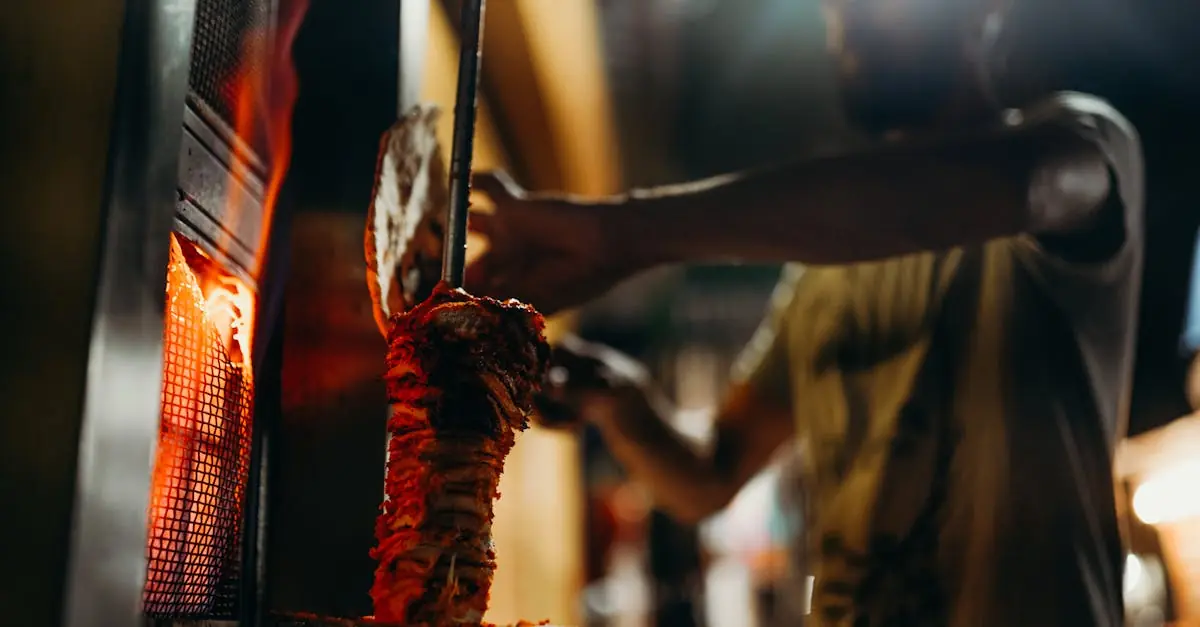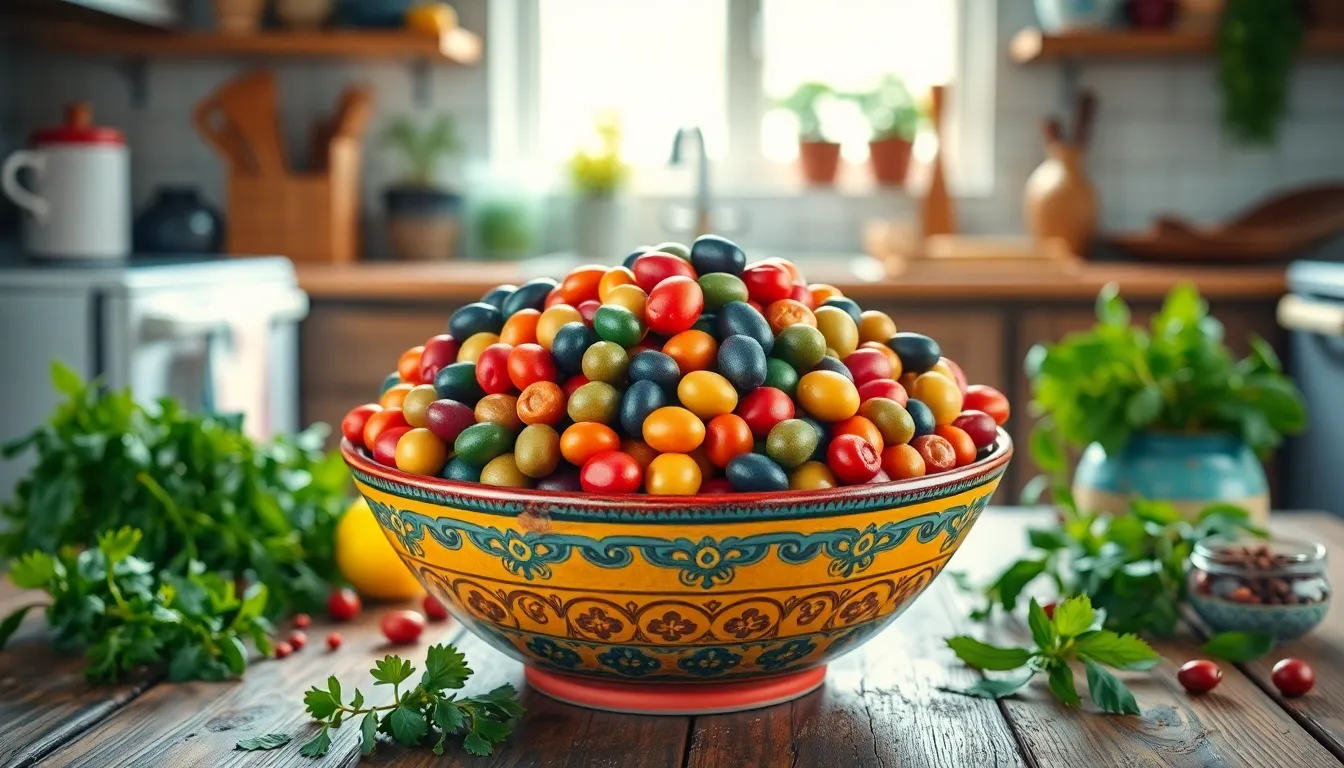Indian cooking techniques are a vibrant tapestry woven with history, culture, and a pinch of spice. From the sizzling sounds of tempering spices to the gentle simmer of a curry, these methods bring dishes to life in ways that’ll make your taste buds dance. If you’ve ever wondered how to turn a simple ingredient into a mouthwatering masterpiece, you’re in for a treat.
Table of Contents
ToggleOverview of Indian Cooking Techniques
Indian cooking techniques embody a rich culinary tradition that reflects cultural heritage. Various methods transform ingredients into distinctive dishes, making each meal unique.
Sautéing involves cooking spices in oil over medium heat, releasing essential oils and flavors. This technique, often called tempering, establishes the base for many sauces and curries.
Slow cooking, prevalent in Indian households, allows flavors to meld over time. Curries simmer gently, developing deep flavors that are both complex and satisfying.
Grilling, or tandoori cooking, uses high heat to impart a smoky flavor to meats and vegetables. Traditionally done in a clay oven, this method enhances the natural taste of the ingredients.
Steaming retains nutrients and texture, commonly used for dishes like idlis and dhoklas. This technique ensures vibrant flavors while providing healthier options.
Frying adds a crispy texture to snacks and main courses. Deep-fried foods, such as samosas and pakoras, are staples in Indian cuisine, offering irresistible crunch.
Baking also finds its place, particularly in bread preparation. Naan and roti, often made in a tandoor, showcase a unique blend of techniques that create soft, flavorful breads.
Each technique contributes to a sensory experience, from the sizzling sounds to the vibrant aromas. Mastering these methods allows cooks to create authentic, delicious Indian meals. Understanding these techniques encourages exploration of the diverse Indian culinary landscape.
Traditional Techniques
Traditional Indian cooking employs unique methods that enhance flavors and textures. Two prominent techniques are tandoor cooking and dum cooking, each contributing distinct characteristics to various dishes.
Tandoor Cooking
Tandoor cooking utilizes a clay oven known as a tandoor. This method generates high heat by burning charcoal or wood, resulting in perfectly cooked meats and breads. Breads like naan and roti become fluffy and slightly charred, while marinated meats develop a smoky flavor. Both kebabs and skewered vegetables benefit from this technique, as the intense heat seals in juices, creating succulent dishes. This ancient method persists in Indian kitchens, symbolizing cultural heritage and culinary excellence.
Dum Cooking
Dum cooking focuses on slow, sealed cooking to allow flavors to meld. A heavy-bottomed pot, or handi, traps steam and heat, ensuring even cooking. Ingredients often include marinated meats, fragrant spices, and basmati rice. The process typically employs a dough seal around the lid to prevent steam from escaping. The slow process can take several hours, resulting in tender, aromatic dishes like biryani. Dum cooking reflects the beauty of patience in Indian cuisine, showcasing rich flavors and textures.
Regional Variations
India’s regional diversity significantly influences cooking techniques. Each area showcases unique styles that highlight local ingredients and traditions.
Northern Indian Techniques
Northern Indian cooking emphasizes rich, creamy curries and bread. Techniques like tandoor cooking create flavorful naan and tender meats by utilizing a clay oven’s high heat. Additionally, sautéing spices in ghee enhances depth, while slow cooking melds complex flavors. This region often relies on dairy products, with pots simmering for hours to develop rich textures in dishes like butter chicken. Grilling meat skewers, known as kebabs, imparts smoky notes, making southern Asian spices even more aromatic.
Southern Indian Techniques
Southern Indian cuisine features lighter, spicier fare with an emphasis on rice. Steaming is common for preparing idlis and dosas, which retain nutrients and create fluffy, fermented textures. Coconut oil is frequently used, introducing a unique flavor. Tempering mustard seeds, curry leaves, and dried red chilies in oil releases essential oils, enhancing the dish’s aroma. Quick stir-frying, often called tadka, infuses flavors into vegetable dishes, while slow-cooked curries build layers of taste. These techniques create balanced meals centered around rice and lentils.
Modern Adaptations
Modern adaptations of Indian cooking techniques incorporate a blend of traditional methods with contemporary approaches. These innovations reflect changing lifestyles and dietary preferences.
Fusion Techniques
Fusion techniques showcase Indian cuisine’s versatility by integrating global flavors. Chefs experiment with ingredients, such as incorporating Italian herbs into traditional curries or creating quesadillas filled with spiced potatoes. This experimentation results in dishes like tandoori pizza, which combines the smoky flavors of tandoor cooking with a classic Italian favorite. Collaboration between cuisines enhances creativity, inviting food enthusiasts to explore new taste combinations that retain the essence of Indian spices while appealing to broader palates.
Healthier Cooking Methods
Incorporating healthier cooking methods has gained traction in modern Indian kitchens. Steaming, for instance, promotes nutrient retention, resulting in lighter dishes without sacrificing flavor. Grilling, another popular technique, reduces oil usage while infusing a smoky taste into meats and vegetables. Chefs often choose baking over frying to create lighter versions of traditional bread, such as whole wheat naan. These adaptations reflect a growing awareness of health and nutrition while allowing traditional flavors to shine through.
Essential Equipment
Specific tools enhance efficiency in Indian cooking. A heavy-duty karahi or wok is essential for frying and sautéing, as its high sides prevent splatter and allow for easy tossing. A tava, a flat griddle, serves multiple purposes, from making roti or dosa to toasting spices.
Investing in a pressure cooker significantly speeds up cooking, especially for lentils and rice, tenderizing ingredients while retaining flavors. A tandoor is invaluable for traditional dishes, though modern alternatives like electric tandoors allow for similar cooking results at home.
Utilizing a stone grinder or mortar and pestle aids in creating fresh spice blends, bringing out maximum flavor from whole spices. Blenders also play a crucial role, helping to make smooth pastes and sauces that are foundational in many recipes.
A spice box organizes essential spices, such as cumin, coriander, and turmeric, allowing for quick access while cooking. Utensils like wooden spatulas and ladles are preferred; they’re gentle on cookware and can withstand high temperatures.
Finally, a set of durable mixing bowls and measuring cups ensures accurate measurements, which is critical for achieving the right balance of flavors in Indian cuisine. The right equipment simplifies complex cooking processes, enabling cooks to focus on the art of creating delicious meals. Each tool serves a unique purpose, reflecting the intricacy and variety of Indian cooking techniques.
Exploring Indian cooking techniques reveals a culinary landscape rich in tradition and innovation. Each method offers a unique way to enhance flavors and create memorable dishes. From the smoky allure of tandoor cooking to the patience required for dum cooking, these techniques highlight the artistry behind Indian cuisine.
As home cooks embrace both traditional and modern methods, they unlock the potential to experiment and create. With essential tools at their disposal, anyone can dive into the vibrant world of Indian cooking. This journey not only satisfies the palate but also connects them to the rich cultural heritage that defines India’s culinary practices.




